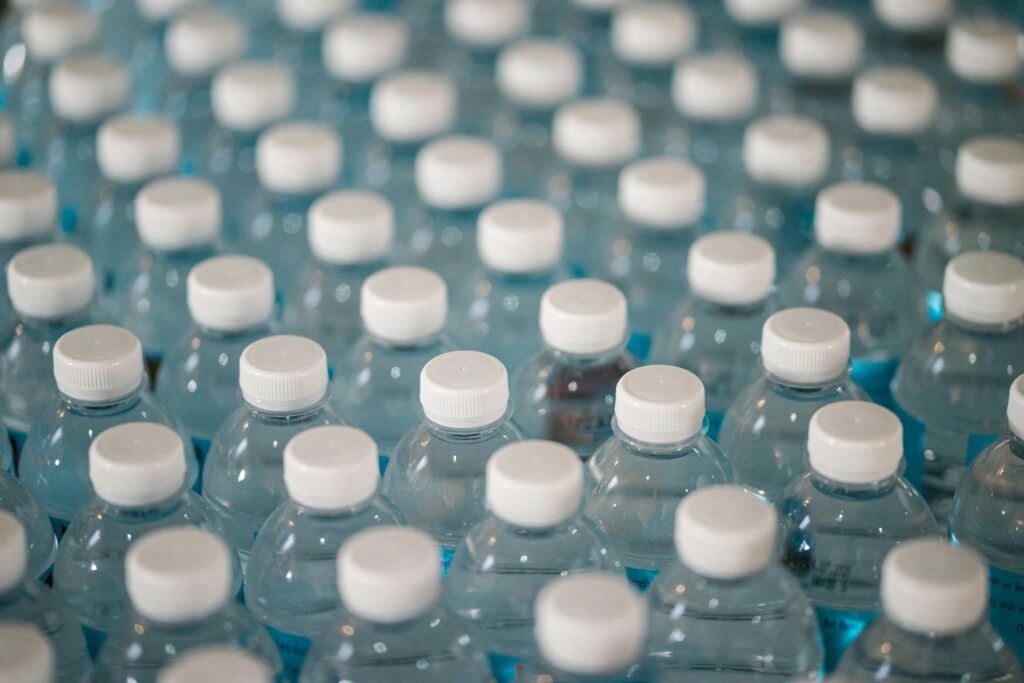1. What is bisphenol A?
Definition and history of its use
Bisphenol A is a synthetic organic molecule belonging to the aromatic family of compounds. It was first discovered in 1891 by Russian chemist Alexander Dianin, but its industrial use only really took off in the mid-20th century. Since then, BPA has become a key ingredient in the production of plastics and resins.
BPA is particularly used to make polycarbonate plastics, known for their transparency, lightness, and impact resistance. These materials are found in a variety of products, such as reusable bottles, optical lenses, and CDs/DVDs. Additionally, BPA plays a central role in the manufacture of epoxy resins, which serve as a protective coating for food cans, beverage cans, and industrial coatings.
YesWeLab carries out specialized analyses to ensure that materials in contact with food (plastics, metals, papers, inks, varnishes) comply with European (EC 1935/2004) and American (FDA) standards through global and specific migration tests.
The industrial sectors concerned
In France, nearly sixty industrial sectors still use BPA or its derivatives today. These include the manufacture of cables, adhesives, sealants, brake fluids, medical devices, and printing inks used for receipts. Its versatile uses make it an essential substance in many fields, but also a potential source of contamination for the general public.
Chemical properties and characteristics
Bisphenol A is an aromatic compound consisting of two phenol groups linked by a methylene bridge. This chemical structure gives BPA high thermal and chemical stability, properties sought after in the production of sustainable materials. However, these same characteristics also make it a persistent substance in the environment, difficult to biodegrade, and likely to accumulate in ecosystems.
With limited solubility in water but a strong affinity for fats, BPA can migrate into food and beverages when used in food containers. This migration is accentuated by heat or pH changes, posing a major risk to human health.
Why has Bisphenol A become a concern?
Scientific interest in BPA is primarily due to its endocrine-disrupting properties. This molecule is capable of mimicking natural hormones, such as estrogen, and thus disrupting the body's normal hormonal functions. The first studies on its effects date back to the 1990s, revealing a correlation between BPA exposure and reproductive, metabolic, and neurological disorders.
2. The effects of bisphenol A on human health and the environment
Bisphenol A is a major health and environmental concern due to its chemical properties and widespread distribution. This endocrine disruptor has significant effects on human health, particularly in the most sensitive populations, as well as on ecosystems.
Impacts on human health
Bisphenol A acts as an endocrine disruptor, meaning it interferes with the hormonal system by mimicking or blocking the action of natural hormones. These disruptions can cause various disorders, including reproductive, metabolic, and neurological disorders.
In humans, prolonged exposure to BPA has been linked to decreased fertility, developmental disorders in fetuses and young children, and an increased risk of metabolic diseases such as type 2 diabetes. Studies have also linked BPA to behavioral disorders, including attention deficit hyperactivity disorder in children.
Pregnant women and infants are particularly vulnerable. BPA can cross the placental barrier, exposing the fetus to concentrations that can affect its development. Additionally, research has shown that in utero exposure can have long-term consequences, such as increased susceptibility to hormone-dependent cancers.
Environmental effects
Bisphenol A, due to its resistance to chemical and biological degradation, is a significant source of environmental pollution. This substance can accumulate in soils, surface waters and sediments, where it persists for long periods.
In aquatic environments, BPA poses a direct threat to wildlife. It is known to disrupt the reproductive cycles of fish and amphibians, leading to population reductions. In some organisms, such as aquatic invertebrates, it causes abnormalities in development and growth.
Terrestrial ecosystems are not spared. When plastic waste containing BPA degrades, it releases this substance into the soil, compromising the quality of agricultural land and potentially affecting food chains.
Sources of exposure
Exposure to bisphenol A can occur through several routes:
- Food route : This represents the main source of exposure, with BPA migrating from food containers (cans, polycarbonate bottles) into food and beverages.
- Skin : Using thermal paper, such as receipts, directly exposes the skin to BPA. This route is of particular concern for professionals who regularly handle these materials.
- Inhalation : Although less common, this route of exposure can occur due to BPA emissions into the ambient air of industrial environments.
The urgency of reducing exposure
Given these risks to human health and the environment, the need to reduce exposure to BPA has become a priority for health authorities. Phased bans and substitution recommendations aim to protect the most vulnerable populations while limiting the environmental impact of this persistent substance.
Are you looking for an analysis?

3. Regulations surrounding bisphenol A
Growing concerns about the health and environmental effects of bisphenol A have led to rapid regulatory changes at both national and European levels. These measures aim to protect vulnerable populations and regulate the use of this substance in industry.
The first regulatory actions in France
France was one of the first countries to act to reduce its population's exposure to bisphenol A. In 2012, Law No. 2012-1442 was adopted to suspend the manufacture, import, export, and marketing of food containers containing BPA. This ban came into effect on January 1, 2015, marking an important step in managing the risks associated with this substance.
At the same time, the French National Agency for Food Safety (ANSES) played a key role by publishing reports in 2011 on the health effects of BPA and recommending its substitution in materials in contact with foodstuffs, particularly to protect infants, young children and pregnant women.
Measures at European level
The European Union has also strengthened its regulatory framework over the years. Initially, Regulation (EU) No. 10/2011 limited the specific migration of BPA into food contact materials. However, in response to new scientific data, the European Food Safety Authority (EFSA) re-evaluated the tolerable daily intake (TDI) in 2023, reducing it to 0.2 nanograms per kilogram of body weight per day, down from 4 micrograms previously.
In December 2024, Regulation (EU) No. 2024/3190 marked a decisive turning point by completely banning the use of BPA in food contact materials. This ban also includes its salts and derivatives, with some strictly regulated exceptions, such as large-capacity containers (> 1000 liters) and certain filtration membranes, provided that BPA remains undetectable (limit of 0.01 mg/kg).
Obligations for manufacturers
The regulation also imposes new requirements on manufacturers and distributors, including:
- Declaration of Conformity (DoC) : All materials intended for food contact must be accompanied by a declaration certifying the absence of BPA or, where applicable, compliance with regulatory thresholds.
- Transition period : Companies have 18 months to adapt their production processes. Exceptional exemptions, limited to three years, may be granted if documented evidence demonstrates the absence of viable alternatives.
Substitute management
While the BPA ban is an important step, it raises the question of substitutes. Authorities, including the European Commission, have expressed concerns about the use of alternative bisphenols, such as bisphenol S (BPS) or bisphenol B (BPB), which have similar endocrine-disrupting properties. As a result, these compounds have also been included in recent regulations to avoid the unfortunate phenomenon of substitution.
Towards global harmonization
While the European Union and France are at the forefront of regulation, other regions of the world are also beginning to limit the use of BPA. In the United States, for example, the Food and Drug Administration (FDA) has banned its use in infant feeding bottles and cups, although overall restrictions are less stringent than in Europe. This gradual harmonization is crucial to reducing global exposure to BPA and its negative impacts.

3. Analytical techniques for the determination of bisphenol A
Bisphenol A (BPA) analysis is essential to ensure regulatory compliance and the safety of food contact materials. Specialized laboratories use advanced techniques to detect and quantify this substance, meeting the requirements of industries and regulatory authorities. This section explores the main analytical methods used for BPA determination, focusing on their principles, limitations, and application.
Soxhlet extraction coupled with HPLC-MS: a reference method
Soxhlet extraction, combined with high-performance liquid chromatography -mass spectrometry (HPLC-MS), is a widely used technique for the determination of bisphenol A.
Principle of the method
The method begins with the extraction of BPA from solid or polymer matrices using a specific organic solvent in a Soxhlet apparatus. This step frees the substance from complex materials, ensuring complete and efficient extraction. The extract is then analyzed using HPLC-MS, a technique that separates and identifies chemical compounds based on their mass and chemical properties.
Limit of quantification (LOQ)
The sensitivity of this method is exceptional, with a limit of quantification below 0.01%. This precision is crucial to ensure compliance with the most stringent regulations, particularly those imposed by the European Union.
Benefits and Applications
This method is ideal for polymers, varnishes, and food coatings. It offers reliable and reproducible results, even for complex matrices. Certified laboratories favor this technique due to its robustness and ability to detect low concentrations of BPA.
Sampling media and sample preparation
The choice of sampling medium is crucial to ensuring the accuracy of results. Samples must be collected in specific, leak-proof, and inert containers to avoid any contamination or alteration of the analyzed compounds. Accredited laboratories define strict protocols to ensure the traceability and quality of analyses.
Rigor in sample preparation
Prior to analysis, samples are packaged to prevent BPA degradation. This includes using certified containers and following specific storage conditions.
Quality standards and certifications
The laboratories carrying out these analyses are often ISO 17025 accredited, guaranteeing reliability and precision of results in accordance with regulatory requirements.
4. Recent scientific studies on bisphenol A
Scientific research on bisphenol A has intensified in recent decades due to growing concerns about its effects on human health and the environment. These studies have deepened our understanding of this substance and helped shape current regulations.
EFSA's risk reassessment
In 2023, the European Food Safety Authority (EFSA) published a new risk assessment of bisphenol A, marking a turning point in the understanding of its health effects. Experts significantly reduced the tolerable daily intake (TDI) from 4 micrograms to 0.2 nanograms per kilogram of body weight per day . This revision is based on recent data showing that exposures to very low doses can impair the immune, reproductive, and nervous systems.
This drastic reduction in the TDI highlighted the need to re-examine population exposure levels and risk management measures. Canned products, identified as a major source of BPA migration into food, were the focus of these investigations.
Effects on fetal and infant development
Epidemiological and experimental studies have shown that exposure to bisphenol A during pregnancy can have long-term effects on child development. BPA crosses the placental barrier, exposing the fetus to concentrations that can disrupt organ development, including the brain and reproductive system.
Researchers have also identified links between early exposure to BPA and the development of metabolic disorders, such as childhood obesity. These findings underscore the importance of protecting pregnant women and infants from this substance, which justifies the strengthened regulatory measures adopted in recent years.
The impact on the intestinal microbiota
Another notable advance concerns the effects of bisphenol A on the gut microbiota. Recent research has revealed that chronic exposure to BPA can disrupt the balance of gut bacteria, leading to inflammation and an increased risk of metabolic and immune diseases. These findings open new perspectives on the mechanisms of action of BPA beyond its role as an endocrine disruptor.
Migration and environmental persistence
Studies on the migration of BPA in the environment have also contributed to a better understanding of its ecological impacts. BPA can contaminate soils and waterways, where it persists for long periods. Particular attention is being paid to micropollutants resulting from the degradation of BPA-containing plastics, which can accumulate in aquatic and terrestrial wildlife.
Additionally, studies have shown that storage conditions for plastic products, such as heat and pH fluctuations, significantly influence BPA migration into food and beverages. These data reinforce the need for improved packaging design to minimize risks.
Towards new research approaches
Current research focuses on developing more sensitive detection methods to monitor BPA exposure and its alternatives. Biometrology techniques, which measure BPA levels in bodily fluids (urine, blood), provide a more accurate picture of individual exposures and better target at-risk groups.
Furthermore, interdisciplinary studies combining toxicology, epidemiology, and molecular biology play a key role in the comprehensive understanding of the effects of BPA. These approaches not only help assess the hazards of this substance, but also guide decision-makers in developing appropriate policies.

5. Regulations related to the dosage of bisphenol A
Regulations regarding bisphenol A (BPA) have tightened considerably in recent years in response to health and environmental concerns related to this substance. These measures include strict detection limits, targeted bans, and specific laboratory testing requirements. This section examines the main regulations governing BPA measurement and their implications for manufacturers.
European regulatory framework
Ban on the use of BPA in food contact materials
Since January 1, 2015, France has banned the manufacture, import, export, and marketing of any food packaging containing BPA. This initiative has been extended to the European level with Regulation (EU) 2024/3190 , which came into force in January 2025.
- This regulation completely bans BPA in plastics, resins, printing inks, silicones and other food contact materials.
- Detection thresholds are set at very strict levels, often less than 0.01%, to ensure that this substance does not migrate into foodstuffs.
Traceability obligations and declaration of conformity (DoC)
Manufacturers and distributors must provide a declaration of conformity for all materials that may contain bisphenols, including:
- The guarantee that products meet regulatory thresholds.
- Complete documentation of the analyses carried out, including the methods used and the limits of quantification (LOQ). These declarations must accompany the materials throughout their distribution chain, ensuring total transparency for authorities and consumers.
Roles of accredited laboratories in compliance
Analytical standards and certifications
BPA analyses must be carried out by accredited laboratories, compliant with ISO 17025 . These laboratories guarantee:
- The use of validated methods, such as Soxhlet Extraction coupled with HPLC-MS or HS-GC-MS screening .
- The accuracy of the results, with quantification limits adapted to regulatory requirements (< 0.01% for BPA).
Materials monitoring and validation
Laboratories play a key role in validating materials used in the food, cosmetics, and pharmaceutical industries. Their expertise is essential for:
- Identify potential sources of BPA migration.
- Propose corrective solutions and secure alternatives in the event of non-compliance.
Penalties and risks for non-compliance
Regulatory sanctions
Manufacturers who do not comply with the thresholds or compliance declaration obligations are exposed to severe sanctions:
- Immediate withdrawal of the affected products from the market.
- Financial fines and legal proceedings.
Risks to brand image
Non-compliance can also harm companies' reputations, particularly in a context where consumers are increasingly attentive to product safety and environmental impacts.
Implications for manufacturers
Current regulations require strict control of the dosage of BPA in materials and finished products. This requires:
- Collaboration with certified laboratories to carry out precise and documented analyses.
- The implementation of BPA substitution strategies with safer alternatives.
- Constant regulatory monitoring to anticipate legislative developments.
These requirements aim to protect consumer health while encouraging industries to adopt more responsible and innovative practices.
YesWeLab: Your partner for Bisphenol A analysis
YesWeLab offers specialized analyses for food contact materials.
Global and specific migration tests ensure that materials (plastics, metals, paper, inks, varnishes) do not transfer hazardous substances to food, thus ensuring compliance with European (EC Regulation No. 1935/2004) and American (FDA) standards.
Additional analyses available on YesWeLab:




